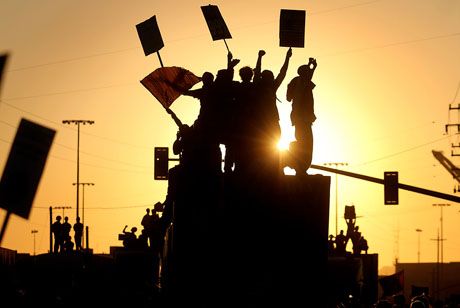Features
You are here
What would it take to stop Austerity?

March 1, 2012
The recent settlements by the Canadian Auto Workers (CAW) in London over the closure of the Electro-Motive Diesel (EMD) plant and by Canadian Union of Public Employees (CUPE) Local 416 with the city of Toronto have raised questions about how we build a serious fight-back against austerity.
In both cases, the unions had built solidarity and there was broad community support, including mass demonstrations. In the case of CAW, support came from all corners, including business journalists who called for nationalization and retailers who pulled Caterpillar (CAT) products from their shelves. The Ontario Federation of Labour (OFL) moved quickly to call a mass demonstration in London against the threat of a plant closure. Several thousand mobilized, the majority from the London area, but also from as far away as Ottawa.
Many had seen these struggles—in particular, the struggle against EMD and CAT—as a potential catalyst to turn back the defeats suffered by previous big strikes and lockouts, such as US Steel, Inco and city workers. There was widespread hope that the CAW members and leadership would take inspiration from the Occupy movement and take over their plant.
Occupy?
Unfortunately, but not surprisingly, there was never any serious threat to occupy from the CAW leadership; instead, the focus was on gaining more favourable severance terms and accepting that nothing could be done to stop the closure. Hopes were also dashed by the settlement of CUPE 416 with the city of Toronto for a contract that saw job cuts and rollbacks. While not as deep as Rob Ford had hoped, the cuts were nevertheless a blow to the aspirations for a larger union-led fight against Ford.
This has led some to question the importance (and even the relevance) of unions in the fight against austerity, arguing instead that power lies in community groups and small circles of “radical” activists. Others have correctly decried the conservatism of the union leadership and demanded more militant action, making the crucial distinction between the labour bureaucracy and its rank-and-file base. (continued below)
Greek trade unionists rally in Syntagma Square in Athens on October 19, 2011.
Even before the settlement at CAT, many activists had criticized the solidarity demonstration in London on January 21 for not going to the picket line and for not attempting to occupy the plant. It’s clear that there would have been broad popular support for an occupation of the CAT plant, much more so than a strike by 416, and that the CAW’s leadership, despite its occasional militant posturing, was not really interested in leading such a fight.
How do we fight back?
Some in the movement have argued that the role of the left is to “expose” the union leadership and attack it for refusing to fight against austerity measures in a serious way. Others argue that we need to find ways to “take back” the unions by electing more left-wing leaders. Both of these strategies, however, fall short of what is necessary to build a stronger, more militant fight against the employers’ immediate attacks and the broader austerity agenda.
Both of these strategies locate the potential for a stronger union movement at the top of the unions, and not at its rank-and-file base, among the wider membership. The first strategy is based on shouting at union leaders, simply demanding that they do more—without recognizing the inherently conservatizing role of the union leadership, or the near impossibility of imposing demands on the union from outside the union membership. It assumes that, by denouncing the leadership of unions for not being more radical, activists will make the unions more radical.
This doesn’t mean that activists inside and outside the union shouldn’t make demands on the leadership. Of course, they should! But they need a strategy that creates real pressure from below on union leaders to make them follow through. More crucially, they need a strategy that doesn’t rely solely on the leadership.
Unions under capitalism
Another mistake in orienting almost exclusively to union leaders is the assumption that they can (and should) play the role of a revolutionary organization. The nature and structure of unions under capitalism shows this is not possible. Unions exist to unite all employees of a single work site or workplace, regardless of their individual politics. In addition, union leaders see their role as striking a balance between the demands of their members and those of the employers. In essence, they see their role as getting the best possible deal within the constraints of capitalism, not as overthrowing it. Trade unions exist to mitigate exploitation, not end it altogether.
The second strategy—simply electing more left-wing leaders—also locates the problem at the top of the unions, assuming that better leaders will automatically lead to a more militant fight-back. Unfortunately, the history of the workers’ movement is filled with left leaders who, once elected, behave as badly as, if not worse than, those seen on the right. The experience of Buzz Hargrove as CAW president is one such example.
Again, this doesn’t mean that militants shouldn’t take union elections seriously, or that they shouldn’t fight to elect and defend left-wing leaders. The recent rank-and-file mobilization at the OFL convention to support the Unity slate led by Sid Ryan, in response to right-wing OFL leaders who were trying to divide and demobilize the labour movement, is a case in point. This was an important victory, but on its own, it’s not enough. Even the best left-wing union leaders are no substitute for a genuinely engaged and mobilized rank-and-file base. In fact, the former can actually do very little without the support and strength of the latter.
Rank-and-file base
This is the key to building a stronger fight-back in labour: winning rank-and-file members of the union to making change themselves. Without pressure from an organized and active rank-and-file base, union leaders (whether left or right) almost always succumb to the pressure of the employers. But building this base takes patient and regular work. It means cultivating relationships and trust between militants and their co-workers, engaging them on all the issues the union faces, and involving them in all the decisions about how to fight back. This is not the same as passing “radical” resolutions or regularly denouncing the leadership. Building rank-and-file resistance means building the confidence of ordinary workers to fight back on their own behalf, and not simply to support others to do it for them, whether fellow union militants or “radicals” in the movements.
Greece
In Greece today, the parties of the far left are now polling higher than the Tory and Social Democratic parties combined. There is nothing automatic about this development. Instead, it is the result of organized revolutionaries agitating in their workplaces, not just when struggle is at a high level, but also during periods of relative quiet and on a regular day-to-day basis.
It might seem to some activists that the slow, patient work of building roots inside workplaces isn’t really radical. But it’s actually the most radical thing. The explosion of struggles in the 1930s and 40s in Canada was based on the work of hundreds of dedicated revolutionaries, working both with and against the union leaderships.
If there is one lesson from the revolutions of the last century, it is this: only the mass activity of the working class itself can make radical, sweeping change. The tactics we use will no doubt change and vary, depending on the struggle. But it isn’t the tactic that determines what’s radical. What’s really radical is winning larger and larger numbers of workers to the position that they themselves can collectively make change—the kind we need in the short term to resist austerity, and in the long term to get rid of capitalism.
Section:
- Log in to post comments










